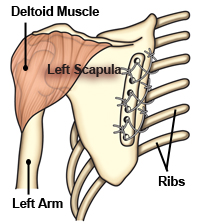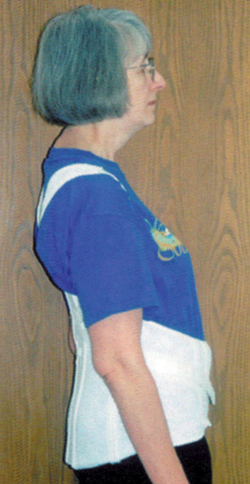
Facioscapulohumeral Muscular Dystrophy (FSH, FSHD)
Medical Management
Medical treatments for facioscapulohumeral muscular dystrophy (FSHD) are relatively few, and none are specific to the disease. There is no treatment that can halt or reverse the effects of FSHD, but there are treatments and devices to help alleviate many of the symptoms.
Anti-inflammatory drugs known as nonsteroidal anti-inflammatories, or NSAIDs, are often prescribed to improve comfort and mobility. These are the same drugs taken by many people with arthritis and other inflammatory conditions. Antidepressants or antiepileptics are appropriate for chronic pain.
Surgical and mechanical help People with FSHD who have at least one strong deltoid muscle (at the top of the arm) may choose to have a surgical procedure in which the scapula (shoulder blade) is tethered to the back of the rib cage, allowing the deltoid the leverage it needs to lift the arm.
People with FSHD who have at least one strong deltoid muscle (at the top of the arm) may choose to have a surgical procedure in which the scapula (shoulder blade) is tethered to the back of the rib cage, allowing the deltoid the leverage it needs to lift the arm.

Surgical procedures to stabilize the shoulder blades (scapulae) by attaching them to the ribs have helped some people with FSHD.
In this procedure, the scapulae are fixed to the ribs so that they do not move. The patient gains some leverage with the arm on the side that’s had the operation because the scapulae no longer slide around.
Although this type of surgery may actually decrease the arm’s range of motion (because the shoulder blade can no longer rotate normally), the ability of the arm to function may be better because the arm’s leverage point is now stable.
It is important to go to a surgeon who fully understands FSHD and has had experience with this exact type of surgery.
Orthoses
Physical therapists often recommend devices such as back supports, corsets, girdles, and special bras for people with FSHD. These supports help to compensate for weakening muscles in the upper and lower back.
Lower leg braces, known as ankle-foot orthoses, or AFOs, can compensate for weakening muscles in the lower leg that cause tripping and falling. These may be recommended by a physician or physical therapist and can be purchased as off-the-shelf or custom-made models. Some people find a lightweight, high-top shoe can be as helpful as an AFO in supporting the foot, at least in the early stages of weakness.

Massage or warm, moist heat (for example, from hot packs you can put in a microwave) are also good for the discomfort associated with FSHD.
Patients with severe early-onset forms of FSHD may benefit from physical, occupational, and speech therapy.
Exercise
Because the precise underlying defect that causes muscle loss in FSHD is not yet understood, it is hard to make precise recommendations about exercise. However, physical therapists who have observed people with FSHD for many years say that moderate exercise appears to do no harm and may even be helpful, at least for muscles that have not severely weakened.
Therapists advise that exercise should not cause muscle cramping, significant muscle pain, or extreme fatigue. An exercise program for someone with FSHD should be directed by a professional, such as a physical or occupational therapist, who has experience with neuromuscular disorders. The program should emphasize exercising muscles that are still relatively strong and resting those that have weakened. This can be accomplished with careful positioning and adaptation of standard exercise regimens.
2015 guidelines from the American Academy of Neurology (AAN) and the American Association of Neuromuscular & Electrodiagnostic Medicine (AANEM) state that clinicians might encourage low-intensity aerobic exercise for patients with FSHD.
For more on this topic, see Exercising with a Neuromuscular Disease.
Diet
There is no specific diet known to help in FSHD or any other muscular dystrophy.
Consult with your MDA Care Center physician about specific dietary recommendations for you and for advice on dietary supplements. Some doctors recommend the dietary supplement creatine for people with muscle disorders, but it should be taken with care and under medical supervision.
FSH Care Guidelines for Clinicians (Downloadable PDF)
FSH Care Guidelines for Patients and Families (Downloadable PDF)

